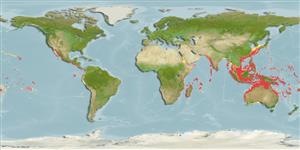Common names from other countries
Classification / Names / Names
Common names | Synonyms | Catalog of Fishes (gen., sp.) | ITIS | CoL | WoRMS
Environment: milieu / climate zone / depth range / distribution range
Ecology
Benthic; depth range 3 - 200 m (Ref. 99750). Tropical
Indo-Pacific.
Length at first maturity / Size / Weight / Age
Maturity: Lm ? range ? - ? cm Max length : 9.0 cm TL male/unsexed; (Ref. 844)
Ranges from creamy white to a pale brown. Characterized by the black line bordering the very sinuous mantle edge, the black edge to the rhinophore pockets, black rhinophore clubs, and the black edging to the simple gills. The gills often rhythmically wave as the animal crawls along.
Assumed maximum length from Ref. 844. Depth range based on occurrence records: minimum depth (Ref. 99751) and maximum depth (Ref. 99750); to be replaced with a better reference.
Life cycle and mating behavior
Maturity | Reproduction | Spawning | Eggs | Fecundity | Larvae
Members of the order Nudibranchia are simultaneous hermaphrodites. Mating behavior: Both individuals darts their penis toward each other to induce one to act as a male and the other as the female. The victorious one to penetrate the body wall is the dominant male. Life cycle: Eggs are deposited on a substratum where they develop and hatch into (planktonic) vestigial veliger larval stage and further grow as adults.
Debelius, H. 2001. (Ref. 844)
IUCN Red List Status (Ref. 130435: Version 2024-1)
CITES status (Ref. 108899)
Not Evaluated
Not Evaluated
Threat to humans
Harmless
Human uses
| FishSource |
Tools
More information
Age/SizeGrowthLength-weightLength-lengthMorphologyLarvaeAbundance
Internet sources
Estimates based on models
Preferred temperature
(Ref.
115969): 20.9 - 28.3, mean 26.8 (based on 1077 cells).
Vulnerability
Low vulnerability (10 of 100).
Price category
Unknown.
